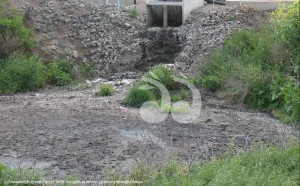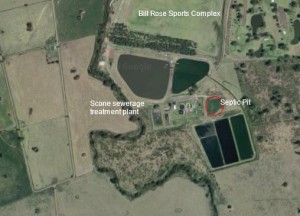Septic Leaks
FOR years liquid from septic waste has been seeping into the local groundwater, according to sources with first-hand knowledge of the Scone sewerage plant.
Late last year the Council hired a private company to conduct testing at the site to investigate the extent that the liquid has impacted on the surrounding groundwater system.
The liquid waste can contain harmful bacteria such as e-coli which is likely to have entered the groundwater, while the water may be used for irrigation or livestock, it is usually not fit for human consumption.
The sources, who wish to remain anonymous, have provided insights into what has been happening at the waste treatment plant in Scone.
While we are still waiting for answers from Council, scone.com.au has been able to cross check the information between sources, industry specialists and the Environmental Protection Agency to verify the information provided.
The pit which received the septic waste was designed to allow settling of solids, with the liquid waste to be processed through the sewerage works.
However, there has been little to no liquid deposited into the sewerage treatment plant, because the pit was not lined and the liquid has been seeping into the surrounding environment.
EPA Raised Concerns Last Year
During an inspection by the EPA in September last year they noted that the pit was not even connected to the sewerage treatment plant for the liquid to be processed.
A spokesperson for the EPA said they expressed their concerns to the Council that there would be potential for groundwater contamination if the council continued to dispose of waste material into the pit.
“The council accepted these concerns and advised that immediate steps would be taken to stop septic tank pump trucks disposing waste into the pit,” said the spokesperson.
“The EPA is now looking to include these upgrades at the plant into a larger Pollution Reduction Program (PRP) on the environment protection licence.
“PRPs are legally binding agreements designed to improve the environmental performance of a licensed facility,” the spokesperson said.
EPA Raised Concerns in 2014
The EPA further described the sewerage treatment plant as “decades old and work is needed to modernise the equipment and ensure the plant operates in accordance with best practice.”
They confirmed they carried out an inspection in early 2014 and highlighted concerns about the sewerage treatment to Council.
“Since then, the EPA has been working with council to develop a comprehensive Pollution Reduction Program,” said the spokesperson.
“This program will be attached to the facility’s licence and will outline the upgrade work that will be required within the next 2-3years to improve overall sewage treatment, discharge and water quality processes,” they said.
scone.com.au has requested the results of Council’s testing.
Related stories:
- Septic Stink, February 26, 2016;
- Septic Costs to Residents, February 27, 2016.
 scone.com.au
scone.com.au
